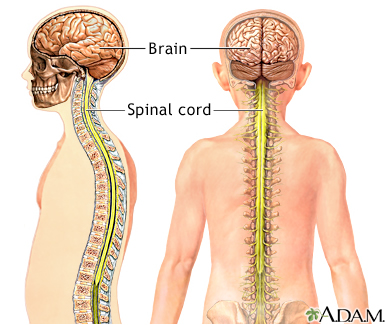Meningitis is a medical condition in which inflammation occurs in the protective membranes that cover your central nervous system (the brain and spinal cord). The inflammation is caused by infection of the fluid surrounding the central nervous system, though not always (sometimes injury, cancer, or certain medications can also cause this inflammation). Since your brain and spinal cord are vital for many body functions, meningitis can affect many other parts of the body!
The brain and spinal cord
Together, your brain and spinal cord form an integration complex system called the central nervous system. This system serves everything you do.
Any problem affecting this system could turn into serious (fatal), especially if the problem is out of control. Meningitis, especially bacterial meningitis, for example is dangerous or even life-threatening if not treated promptly!
Brain
Your brain is a spongy mass of soft tissues and billions of nerve cells. This amazing three-pound organ may be the most complex and magnificent organ of your body. It has three main parts – the cerebrum (the largest part of the brain), cerebellum, and brain stem. All of these parts work together to serve lots of body functions, though each has some specific functions.
The cerebrum consists of two halves called the right and left cerebral hemispheres, which play a key role to use information from your senses so you can handle what’s going on around you and how to respond – as well as for reading, learning, thinking, and emotions.
Additionally, the right hemisphere is important to manage the muscles on the left side of your body. On the other hand, the left hemisphere is responsible to control the muscles on the right side!
Under the cerebrum, especially at the back of your brain, you have the cerebellum. It plays a key role to manage the balance and complex actions of your body such as talking and walking.
At the bottom of the brain, you have the brain stem that hooks up the brain with the spinal cord. It is responsible to manage your thirst and hunger – as well as for some of the most basic functions of your body such as breathing, body temperature, and blood pressure.
Spinal cord
The spinal cord is a fragile, long tubular bundle of nerve fibers. It is the most important tubelike structure between the brain and the body. It begins from at the end of the brain (brain stem) and runs down almost to the spinal column (the bottom of the spine).
Spinal nerves are important to support the brain, because they connect your brain with lots of nerves in most parts of your body. Other nerves are directly connected from the brain to the ears, eyes, and other areas of the head.
What parts of the body does meningitis affect?
Brain and spinal cord are protected by strong structures, the bones of the skull for the brain and the center of the spine’s bones for spinal cord. Both are also covered by three layers of protective membrane called meninges – and also cushioned by watery fluid called cerebrospinal fluid. Meningitis starts to develop when meninges get inflamed.
*Image credit to ADAM
The inflammation of meninges can be caused by a number of reasons. Most cases of the disease are associated with virus infections. And the good news, viral meningitis is usually mild (not serious) – though in a few cases it may also turn into serious.
Bacterial meningitis is not as common as viral meningitis, but it is more dangerous and even life-threatening. It can lead to a number of serious complications if not promptly treated. Fungal meningitis is also often associated with serious problems, but it’s rare.
In all types of meningitis, the primary problem is inflammation of the brain and spinal cord. This inflammation usually causes some of the following common symptoms:
- Unusual skin rash. Typically, you can still see it clearly through the glass (it doesn’t fade even though if you firmly press a clear glass against the affected skin).
- More sensitive to light.
- Stiffness in the neck.
- In severe case, meningitis may cause seizures.
Less common symptoms include a sudden fever, severe-persistent headache, drowsiness, irritability, fatigue, confusion, rapid breathing, joint /muscle aches, off balance, appetite loss, thirst, and general feeling of being sick. In babies, meningitis may also cause poor feeding, inactivity, high-pitched crying, and fontanel (a bulging soft spot, typically on their head).
These symptoms may widely vary from patient to patient. For example, it’s possible for some people with meningitis to not experience skin rash, one of classic symptoms of the disease. A distinctive skin rash is more common in bacterial meningitis.
Since your central nervous system is crucial to support many body functions, and the infection (especially for bacterial meningitis) can spread elsewhere in the body, and even the disease may also coexist with another health condition – meningitis may also affect other the following parts of the body:






Is there a chance for meningitis (including viral meningitis) to turn into serious? For example, my brother said that he had viral meningitis with serious hair loss. Is this issue a myth or a fact? Pleas help